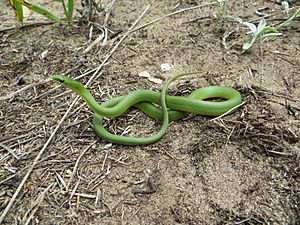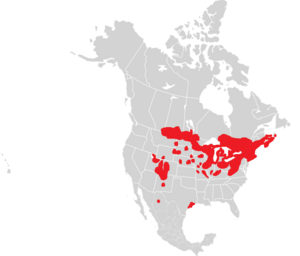Smooth green snake facts for kids
Quick facts for kids Smooth green snake |
|
|---|---|
 |
|
| Smooth green snake in a sand prairie | |
| Conservation status | |
| Scientific classification | |
| Genus: |
Opheodrys
|
| Species: |
vernalis
|
| Synonyms | |
|
|
The smooth green snake (Opheodrys vernalis) is a type of snake found in North America. It is also known as the grass snake. This snake is not venomous, meaning it is harmless to humans. It belongs to the family called Colubridae.
Smooth green snakes are thin and usually measure about 14 to 20 inches (36 to 51 cm) long when they are adults. They are called "smooth" because their scales on their back are smooth. Another snake, the rough green snake, has scales that feel rough. You can find smooth green snakes in wet areas like marshes, meadows, and open woods. They live in parts of Canada, the United States, and northern Mexico. These snakes are not aggressive. They rarely bite and usually try to get away if they feel scared.
Contents
About the Smooth Green Snake
The smooth green snake is a thin snake. It is considered a "small to medium" sized snake. Adults are typically 14 to 20 inches (36 to 51 cm) long, including their tail. The longest one ever found was about 26 inches (66 cm) long. The tail makes up about one-fourth to one-half of the snake's total length. Male snakes usually have longer tails than females.
Its back is a bright, even green color. Its belly is yellow or white. The scales on its back are smooth, which is how it got its name. These smooth scales are arranged in 15 rows around the middle of its body.
When a smooth green snake is born, its color is different. It might be olive green, blue-gray, or even brown. After it sheds its skin for the first time, it turns its famous bright green. The color can also change a bit depending on where the snake lives. For example, some are bluish in Kansas or bronze in northern Wisconsin.
The snake uses its tongue to "smell" its surroundings. Its tongue is red with a black tip. It flicks its tongue in and out to pick up scents from the air.
Types of Smooth Green Snakes
There are a few different types, or subspecies, of the smooth green snake:
- Eastern smooth green snake, Opheodrys vernalis vernalis
- Western smooth green snake, Opheodrys vernalis blanchardi
- Northern smooth green snake, Opheodrys vernalis borealis
Where Smooth Green Snakes Live
The smooth green snake is only found in North America. Its home range stretches across southeastern Canada, going west to Saskatchewan. It also goes south through states like Illinois and Virginia. You can also find them in other areas, including Wyoming, New Mexico, Iowa, Missouri, Colorado, Kansas, Texas, Mississippi, and northern Mexico.
Dangers to Smooth Green Snakes
Many animals hunt smooth green snakes. These predators include red-tailed hawks, great blue herons, bears, raccoons, foxes, and even house cats. People sometimes catch these snakes to keep as pets. Because of their pretty green color, calm nature, and small size, they are sometimes collected for sale. However, these snakes do not usually live long when kept as pets. Since their groups are often small and spread out, collecting them can really hurt their numbers.
The number of smooth green snakes is also going down because of pesticides and habitat loss. Pesticides are chemicals used to kill insects. They are very bad for the snakes, especially near water or in meadows. Since smooth green snakes eat mostly insects, insecticides can poison them or take away their food. This is a big reason why many snakes die.
Their homes are also being destroyed by things like building roads, cutting down trees, and draining streams. Logging and mining can harm snakes living in those areas. Roads and highways are very dangerous for snakes, especially those near water. Farm animals grazing can also reduce snake numbers. Areas without grazing often have more snakes. Grazing can reduce grass, change trees, and make the soil hard. All these things hurt reptiles. Flooding, freezing, and destruction of their winter dens can also kill many snakes.
Fun activities like using off-road vehicles near wet areas also harm their homes. Lakes and streams are great for recreation, but human activity can damage them. Off-road vehicles in wetlands are especially harmful. They can tear up and destroy these important areas. Oil and gas from these vehicles can also get into snake habitats.
Protecting Smooth Green Snakes
Right now, the smooth green snake is listed as a species of "least concern." This means they are not in immediate danger of disappearing. However, people in the U.S. are becoming more worried. Some states report seeing fewer snakes, and new homes are being built in their habitats.
Even though some studies show their numbers are dropping, only a few states protect them. These states include Iowa, Missouri, Indiana, Michigan, North Carolina, Montana, and Texas. Wyoming, Nebraska, and Colorado also have laws to protect them. These laws stop people from collecting the snakes for sale or as pets.
Smooth Green Snake Habitat
Smooth green snakes can live in many different places. These include marshes, meadows, stream edges, and open woods. They like to stay on the ground in open areas without many bushes. When winter comes, they hibernate in groups. They look for burrows, ant hills, or other underground spots to stay warm. They prefer wet places and areas close to water. They often stay in green areas to blend in and hide. Since they are cold-blooded, they like warm spots. They will lie in the sun on rocks and logs, which also give them places to hide.
Smooth Green Snake Behavior
The smooth green snake uses its green color to blend in with its surroundings. This helps it hide from animals that want to eat it. If a snake feels threatened, it usually tries to run away. It is a calm snake and rarely bites. It often lets people get close. If it gets very scared, it can release a smelly liquid from a special gland. When people hold them, they might act excited at first. Then, they often calm down and wrap themselves around a finger.
When hunting, the snake moves its head from side to side. It uses its tongue and a special organ in its mouth to find prey by "tasting" the air. Smooth green snakes do not have ears, so they feel vibrations to understand what is around them. They can see well over short distances. Their jaws can stretch, letting them swallow prey whole, even if it is bigger than their own body. They can shed their skin often, sometimes every four to five weeks, which helps them grow.
During warmer months, smooth green snakes are active both day and night. In the colder winter months, they gather in groups to hibernate. They use ant hills and rodent burrows as temporary homes during this time.
What Smooth Green Snakes Eat
Smooth green snakes mainly eat insects and spiders. Their diet includes caterpillars, harvestmen (daddy longlegs), moths, ants, snails, worms, and slugs. When they hunt, they use both smell and sight to find their food. They kill their prey with a quick strike, not by squeezing it.
Smooth Green Snake Life Cycle
Smooth green snakes become old enough to mate in late spring or summer. Female snakes lay their eggs from June to September. They usually lay two groups of eggs, with four to six eggs in each group. Females often lay their eggs in places like rodent burrows, piles of rotting plants, or old logs. In colder northern areas, many females might lay their eggs together in one spot.
Smooth green snake eggs are white and oval-shaped. They have thin shells and are about one inch long. Each egg weighs about 2.6 grams. The eggs hatch between four and 23 days after they are laid.
Images for kids






